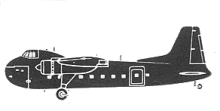Incident Overview

Description
The Bristol departed Blenheim-Woodbourne Airport (BHE) for a cargo light to Timaru (TIU) via Paraparaumu (PPQ). At an altitude of 2500 feet the no. 2 prop was feathered and rate half turns were made in both directions. The prop was unfeathered and normal power restored on the engine. Two minutes later a sudden and severe vibration was felt throughout the aircraft. When the no. 2 prop had been feathered again a little later, no vibration was felt on the remainder of the flight to Paraparaumu. After loading cargo the aircraft then continued to Timaru. At 11:27 the crew contacted Harewood Tower, reporting 6 miles North of Waimakariri River mouth at 3000 feet. Harewood cleared the aircraft to maintain 3000 feet to the Harewood Range Station, descend VFR and proceed to Timaru. At 11:33 eyewitnesses saw the aircraft at about 2000 feet when the right hand outer wing folded upwards and backwards and separated, falling and landing on open farmland. The nose doors, the floor of the freight compartment (with the freight in position), and the rear portion of the fuselage with the fin and rudder attached, separated from the rest of the aircraft just before impact. Pieces were scattered over an area of more than a square mile. The rest of the aircraft ploughed nose down into a row of pine trees on the south-east boundary of the Russley Golf Course. Here the flight deck and front section erupted in a huge sheet of flame and spread to the trees as the unused fuel sprayed over the area. It was found out that a fatigue failure originated in the outermost 0,25inch bolt hole drilled in the wing front spar during the incorporation of Bristol Modification 1169. This modification prolonged the life of the aircraft to 10400 hours because it moved the point of stress concentrated in the boom to a new location. The modification was carried out on January 21, 1954 and the aircraft made 4880 flying hours since (while 7400 hours extended liftetime had been guaranteed). PROBABLE CAUSE: “In-flight structural fatigue failure of the starboard front lower spar boom. The circumstances which made the accident possible were created by the assessment of a life which was materially in excess of the safe life. The error in life assessment stemmed from the fact that simulated operational conditions from which the lifeing data was evolved were not truly representative of actual operating conditions.”
Source of Information
http://library.christchurch.org.nz/Heritage/LocalHistory/Fendalton/crash.asphttp://library.christchurch.org.nz/Heritage/LocalHistory/Fendalton/crash.aspPrimary Cause
Fatigue failure of the outermost 0.25-inch bolt hole drilled in the wing front spar during the incorporation of Bristol Modification 1169.Fatigue failure of the outermost 0.25-inch bolt hole drilled in the wing front spar during the incorporation of Bristol Modification 1169.Share on:




